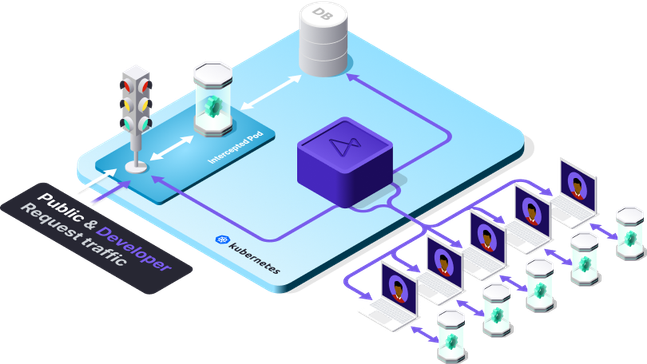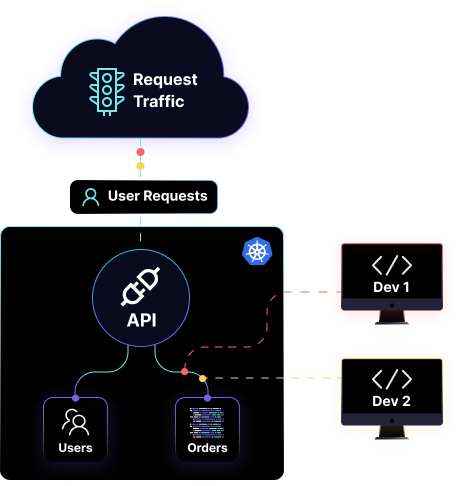Share and collaborate easily
Share work in progress with teammates and colleagues for ease of collaboration and feedback.
Improve developer experience
Use the existing local development, build, and debugging workflows and tools you know and love.
Faster app dev and delivery
Code and ship faster, freeing 50%+ of dev time from manual tasks to launch features and apps faster.
Accelerate your Local Development
Telepresence streamlines your local development process, enhancing the developer experience by enabling immediate feedback. You can launch your local environment on your laptop, equipped with your preferred tools, while Telepresence seamlessly connects them to the microservices and test databases they rely on.
It simplifies and expedites collaborative development, debugging, and testing within Kubernetes environments by establishing a seamless connection between your local machine and shared remote Kubernetes clusters.

Streamline Development and Boost Productivity
Faster feedback loops
Spend less time building, containerizing, and deploying code. Get immediate feedback on code changes by running your service in the cloud from your local machine.
Shift testing left
Create a remote-to-local debugging experience. Catch bugs pre-production without the configuration headache of remote debugging.
Deliver better, faster user experience
Get new features and applications into the hands of users faster and more frequently.
Share development best practices
Standardize development practices across your entire team, sharing dev environments using secure preview URLs.
Simplify setup and use
Eliminate the need for complex infrastructure setup and maintenance. Easily maintain existing local dev, build and debug workflows.
Maximize the value of personal intercepts
Develop and test code locally using intercepted remote traffic, redirecting to your local development environment
How Telepresence Works
Telepresence allows you to code with your usual tools and workflows as if your local machine is part of the remote Kubernetes cluster. It runs your code locally and forwards requests to and from the cluster, skipping the slow process of building, pushing, and deploying containers before seeing code changes.


Command-line interface (CLI) client ->
The Telepresence CLI client is used to connect Telepresence to your cluster, start and stop intercepts, and create preview URLs. All commands are run in the form of Telepresence <command>.


Connects ->
With Telepresence, you can spin up your local environment using connects on your laptop. Using connects, you seamlessly connect with and get insight into your app's remote dependencies.


Global intercepts ->
The global intercepts let you intercept all the traffic intended for a remote service in the Kubernetes cluster and run it locally. By seamlessly integrating with Kubernetes, Telepresence enables real-time interaction with running services while preserving the original network and service discovery.


Personal Intercepts ->
To make sure you're working on just what you need (a subset of all the traffic) and not affecting your teammates, you can use personal intercepts to route requests at a more granular level to individual laptops. For example, you can specify only what you need using request-based isolation (via HTTP headers or path metadata) and work locally, interacting in real-time with services within a shared remote cluster without interfering with others' changes or causing conflicts.
You get what you need while allowing everyone to work simultaneously and efficiently. Fewer remote dev environments are needed, enabling you to save on cloud and maintenance costs.





INTEGRATIONS
Telepresence for Docker
Telepresence for Docker simplifies Kubernetes development, testing, and collaboration for teams. It makes remote clusters accessible locally, offering speed and flexibility for fast, easy Kubernetes development.
Telepresence for Docker Compose
Telepresence for Docker Compose simplifies running multi-container apps, enabling seamless collaboration, debugging, and routing between local and remote Kubernetes services using unmodified Docker Compose files.








